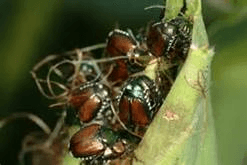Good evening,
Tuesday night was the Fruit and Vegetable Crop Walk program held at Daniel Hostetler’s farm near Mt. Victory. OSU Extension entomologists Celeste Welty, Jim Jasinski, and Curtis Young helped out with the program along with an OSU research associate and graduate students from the Weed Science and Plant Pathology departments. The program began with presentations, followed by a walk through a greenhouse and produce field, pointing out issues and giving recommendations for the produce growers. For more information on this event, see the attached news release and flyer. Our next big event is the Hardin Precision Ag Field Day coming up this coming Wednesday, August 23 at Bill and Shane Kellogg’s farm near Forest. This is one of the Blanchard River Demonstration Farms, which two of the three are located in Hardin County while the other one is in Hancock County. These farms are doing research on various practices to improve water quality in the Lake Erie Watershed, so we know what practices improve water quality while at the same time are economically feasible and sustainable for crop and livestock producers.
Hardin Precision Ag Field Day Flyer
Precision Ag Field Day Event News Release
By now 900 people should have received their postcard about this upcoming field day, so as a last reminder, make sure you register if you plan on attending by Monday at noon. Didn’t get a postcard? Please consider this email as your invitation to participate in this event. I need to tell the caterer how many meals to prepare so make sure you go to go.osu.edu/hardinprecisionagday or call the Hardin County Extension office at 419-674-2297 so we have enough lunches for everyone. Ag Credit is sponsoring the coffee, juice and donuts so you shouldn’t go home hungry. We believe there is an excellent line up of speakers in the morning and field demonstrations in the afternoon, so check out the news release, agenda, and flyer for more details. I hope to see you there as several people have put a great amount of effort into planning this special event for you.
Other local events coming up include Hardin County Fair Work Day, Saturday, August 19 starting at 8:30 am; Master Gardener Volunteers Vegetable Harvest Party, Saturday, August 26 starting at 10:00 am at the Friendship Gardens in Kenton; and the Hardin County Cattle Producers’ Picnic on the same day starting at 6:00 pm in the Community Building at the fairgrounds. I have included some agronomy articles for you to read below if you are interested.
Mark
Register Now for Hardin Precision Ag Field Day – Mark Badertscher
Plan to attend the Precision Ag Field Day to be held August 23 at Kellogg Farms, 17392 Township Road 50 near Forest. Aaron Heilers, project manager for the Blanchard River Demonstration Farms will give an overview of the water quality and nutrient management goals of the three farms in Hardin and Hancock County. Greg LaBarge, OSU Extension agronomist will discuss how Edge of Field research is addressing nutrient management issues in Ohio. Kirt Wells will show how farmers can get started with precision data management to make their farming operation more efficient while Kevin Ward will explain how precision agriculture equipment can be used with the smaller producer. Both Wells and Ward are from Findlay Implement Company. To read more about the Hardin Precision Ag Field Day, go to https://agcrops.osu.edu/newsletter/corn-newsletter/2017-25/register-now-hardin-precision-ag-field-day.
Wind Damage in Corn – “Green Snap” and Root Lodging – Peter Thomison
Strong winds associated with rain storms can cause localized root lodging and “green snap”. The magnitude of this damage is influenced by several factors including crop stage of development and hybrid genetics. Root lodging occurs when strong winds pull corn roots part way out of the soil. The problem is more pronounced when soil are saturated by heavy rains accompanying winds. If root lodging occurs before grain fill, plants usually recover at least partly by “kneeing up.” This response results in the characteristic gooseneck bend in the lower stalk with brace roots providing above ground support. If this stalk bending takes place before pollination, there may be little effect on yield. When lodging occurs later in the season, some yield decrease due to partial loss of root activity and reduced light interception may occur. If root lodging occurs shortly before or during pollen shed and pollination, it may interfere with effective fertilization thereby reducing kernel set. To read more of this article, go to https://agcrops.osu.edu/newsletter/corn-newsletter/2017-21/wind-damage-corn-%E2%80%9Cgreen-snap%E2%80%9D-and-root-lodging.
Cool Nights and Lots of Moisture can Equal Sclerotinia Stem Rot – Jaqueline Huzar Novakowiski , Anne Dorrance
We are past the flowering stage of soybean in many parts of Ohio. The cool nights and wet conditions over the last couple of weeks are very favorable for infection of Sclerotinia sclerotiorum, the fungus that causes Sclerotinia stem rot or white mold of soybean. This is particularly concerning if you have a field with history of this disease and if a susceptible cultivar was planted. The fungus forms sclerotia which are black, hard and irregular bodies with a pink to white center. Sclerotia can survive in the soil for many years, and the cool and wet conditions are favorable for germination and production of apothecia. Note that not every field in Ohio has inoculum. Sclerotia must be introduced into a field with contaminated seed or from another susceptible crop. To learn more about Sclerotinia Stem Rot in soybean, go to https://agcrops.osu.edu/newsletter/corn-newsletter/2017-21/cool-nights-and-lots-moisture-can-equal-sclerotinia-stem-rot.

It’s Beginning to Look a Lot Like – Off-Target Dicamba Movement – our Favorite Time of the Year! – Mark Loux, Bill Johnson
You would probably have to be living under a rock to not at this time be aware of the issues with off target dicamba movement affecting soybeans and other plants in the states of Tennessee, Arkansas, and Missouri. The latter two states banned any additional dicamba applications for the remainder of the growing season to avoid additional problems (subject to change probably), and some changes are coming in Tennessee also apparently. We have seen firsthand examples of this in at least some Indiana and Ohio fields, and have heard about a number of additional ones. It’s somewhat difficult to gauge how widespread the issue is, since there is often reluctance of an affected party to contact regulatory officials and file a complaint, in order to keep good relations with the offending neighbor. Go to https://agcrops.osu.edu/newsletter/corn-newsletter/2017-21/it%E2%80%99s-beginning-look-lot-%E2%80%93-target-dicamba-movement-%E2%80%93-our-favorite to finish reading this article.
Potential for Silk Clipping by Beetles – Andy Michel, Kelley Tilmon
We have received many reports of Japanese beetles and other defoliators munching on soybean over the past few weeks with some reaching economic levels of defoliation. Like a few other insects Japanese beetles are “buffet style” eaters, they have many plants that they can feed on, including corn. On corn, much of the feeding occurs on silks where they chew the silks back to the ear tip and can interfere with pollination. Another well-known insect that can feed on silks is the adult corn rootworm (mainly the Western corn rootworm) that should begin emerging soon, if not already. As tasseling begins and silk emerges, growers will want to make sure that the silk feeding does not reach economic threshold and impact pollination. Common thresholds are: 1) if 5 or more rootworms or 3 or more Japanese beetles are found per ear, 2) if silks have been clipped to within 1/2 inch of the ear tip, and 3) pollination is less than 50% complete. As silk clipping is highest along the edges, growers should check at least 100 plants, (10 plants in 10 different areas) to sample the entire field for any signs of silk clipping.
Mark A. Badertscher
Agriculture and Natural Resources Educator
OSU Extension Hardin County
1021 W. Lima Street, Suite 103, Kenton, OH 43326
419-674-2297 Office
hardin.osu.edu








